Minister Nguyen Manh Hung: The "C = SET + 1" Semiconductor strategy
•
20/08/2024
On August 20, 2024, VietNamNet newspaper published an article by Minister of Information and Communications Nguyen Manh Hung detailing Vietnam's Semiconductor Strategy. The Minister highlighted that the strategy's core focus is on designing and manufacturing chips while also aiming to establish Vietnam as a global hub for the semiconductor workforce.
According to Minister Nguyen Manh Hung, if one were to distill Vietnam's Semiconductor Strategy into a formula, it would be "C = SET + 1".
Regarding the letter C (Chip), Minister Nguyen Manh Hung explained that the core technologies of the fourth industrial revolution are IoT and AI. IoT digitizes the physical world, creating a digital environment and generating data, while AI processes this data to create new value. Semiconductors are pivotal in IoT and AI, fundamentally shaping and transforming the world. They are integral to nearly every device and aspect of daily life, impacting economic and national defense security. This significance is expected to continue, at least until the middle of the 21st century, within the broader context of digital transformation.

Regarding the letter S (Specialized Chip), Minister Nguyen Manh Hung highlighted that Industry 4.0 encompasses new technologies such as AI, IoT, and industrial automation. These applications demand high computing performance, substantial data processing capabilities, and rapid response times. Specialized chips are designed to meet these needs, delivering superior performance compared to general-purpose chips. Additionally, they address specific requirements such as low power consumption for IoT, enhanced security for national critical industrial systems, and unique demands in fields like telecommunications, healthcare, transportation, and energy. Specialized chips also play a crucial role in driving technological innovation.
General-purpose chips often operate at only 10-20% of their capacity when used for specialized applications, leading to inefficiencies, particularly in power consumption and cost. A limited number of manufacturers typically produce general-purpose chips, while specialized chips offer a wide range of possibilities and opportunities. Whereas general-purpose chips characterized Industry 3.0, Industry 4.0 is defined by specialized chips. Future advancements will hinge on the development and application of these specialized chips.
Regarding the letter E (Electronics, Electronics Industry), Minister Nguyen Manh Hung emphasized that the development of Vietnam's semiconductor industry must be accompanied by the growth of the electronics industry and digital transformation. Chips are a crucial component of electronic equipment. Focusing solely on chip production would create dependence on the demand from electronic equipment manufacturers. Successful countries with significant economic growth typically have a well-developed electronics industry. The electronics industry is undergoing a new wave driven by artificial intelligence (AI). Modern electronic devices increasingly require AI integration, with AI chips becoming the core of next-generation technologies. Just as the adoption of chips in consumer electronics in the late 20th century helped Japan become an economic powerhouse, integrating AI chips into electronic devices could position Vietnam as a leading force in the global market. By pursuing this path, Vietnam has a unique opportunity to revitalize and advance its IT industry, potentially becoming a global industry leader.
Developing investment technology drives demand for semiconductors. The electronics industry, which encompasses consumer electronics and specialized equipment for sectors such as telecommunications, healthcare, energy, automotive, aerospace, and defense, is 5-6 times larger than the semiconductor industry. The digital transformation industry is even more significant, driven by the digitization of the physical world through IoT devices. These IoT devices require chips, and their market size far exceeds traditional electronic equipment. While chips for the electronics and digital transformation industries are generally less complex than high-tech semiconductor chips from companies like Intel and Nvidia, the demand is enormous.
Regarding the letter T (Talent), Minister Nguyen Manh Hung highlighted that the key component of the Vietnam Semiconductor Strategy is establishing the country as a global hub for semiconductor talent. This talent hub will serve as a magnet for investment in various aspects of the semiconductor industry, including research, design, production, packaging, and testing. Additionally, the hub will encompass the training and export of skilled labor to support the semiconductor industry, driving growth and development in Vietnam's semiconductor sector.
Vietnam excels in rapidly responding to labor needs through retraining (reskilling) and advanced training (upskilling). With 700,000 engineers in electronics, telecommunications, IT, and digital technology, the country is well-positioned to meet semiconductor industry demands through these methods. Vietnam also leads in STEM (Science, Technology, Engineering, Mathematics) capabilities, graduating hundreds of thousands of new engineers annually in these fields. Human resources are crucial for developing Vietnam's semiconductor industry, covering all stages from design to production and beyond, not just chip design.
Preparing human resources should be guided by forecasts and long-term vision while aligning with market demand. Establishing agreements between training institutions and semiconductor companies, both domestic and international, is crucial to ensuring that training programs meet actual needs and create tangible outcomes. At the national level, the Government will facilitate agreements with countries lacking semiconductor talent to address this gap. Success in training relies on ensuring a clear pathway to employment. Therefore, attention must be given to offering competitive salaries for high-quality semiconductor jobs, ensuring that compensation for semiconductor professionals exceeds average IT standards.
The shortage of semiconductor talent is an immediate challenge, so short-term solutions are also crucial alongside long-term training initiatives — such as STEM education from high school to graduate and doctoral levels. Rapid training through retraining, advanced training, or transition programs is essential. IT, software, and electronics engineers can be prepared for the semiconductor industry with focused retraining over 6 to 12 months. This requires investment in teachers, instructors, facilities, and educational materials. Critical solutions include fostering collaboration between industrial enterprises and universities and investing in training infrastructure. Prioritizing the retraining of educators and attracting international semiconductor experts are crucial steps in addressing the immediate talent gap.
Regarding +1 (X + 1), the global semiconductor industry is shifting toward diversifying the supply chain, moving beyond just production to encompass all stages of the semiconductor value chain. Countries with existing semiconductor capabilities are seeking to establish additional facilities in other countries. Vietnam stands out as one of the few nations with the potential to become a leading player in this diversification. With strong strategic relationships with major semiconductor powers, Vietnam is well-positioned to excel across all stages of the semiconductor value chain, potentially emerging as a top player in the industry.
Focusing on this X+1 strategy will attract foreign direct investment (FDI). Through this approach, Vietnam will offer not only human infrastructure, land, electricity, water, transportation, telecommunications, and tax incentives but also a commitment to safety and security. The semiconductor industry significantly impacts economic security and national defense, making safety a top priority.
Vietnam has significant geopolitical advantages in the semiconductor industry. Positioned centrally, a 4-5 hour flight from Vietnam covers up to 70% of the global semiconductor industry, placing Vietnam at a strategic center for the industry. Additionally, Vietnam is politically stable, rapidly developing, and firmly committed to industrialization, supported by a National Strategy for Industrial Development. This stability and strategic positioning make Vietnam an attractive hub for semiconductor investment and development.
The equation C = SET + 1 represents an innovative approach in the global semiconductor industry. This sector is characterized by its constant innovation and evolving business models, where new models frequently disrupt and surpass the old ones, driving breakthrough developments and creating new semiconductor leaders. With its unique approach, Vietnam's participation aims to contribute to this dynamic environment and potentially introduce a novel business model to the global semiconductor industry.
Indeed, the semiconductor industry is complex and demanding, requiring a unique approach, substantial ambition, and a high degree of determination, perseverance, and willingness to take risks.
As a leading technology enterprise in Vietnam, FPT has been proactive in this field, establishing a semiconductor research team over a decade ago. FPT has also engaged with prominent chip companies like Mediatek and TSMC to explore technological solutions and advancements.
In 2022, FPT launched FPT Semiconductor and secured contracts worth 70 million USD for chips with Korean and Japanese clients. Moving forward, FPT will concentrate on developing power chip products, leveraging its customization, assembly, and fine-tuning strengths to establish a strong market presence quickly.
Mr. Truong Gia Binh, Chairman of FPT, has highlighted Vietnam's opportunity in the semiconductor industry, stating, "The world is choosing us to make chips." Aligned with the Government's objective to train 50,000 semiconductor engineers by 2030, FPT has committed to developing 10,000 skilled professionals. The Corporation is implementing robust training programs across various levels, including short-term courses and higher education. FPT University is recruiting 1,000 students for its IC Design major, offering up to 100% scholarships for all applicants. Additionally, FPT is collaborating with partners from the US, Japan, and Taiwan to enhance human resource training.
Mr. Truong Gia Binh believes Vietnamese youth passionate about science and technology have a significant opportunity to lead in the semiconductor industry. The Chairman of FPT hopes for a collective effort to drive the industry's growth and bring Vietnam to the forefront of semiconductor development.




